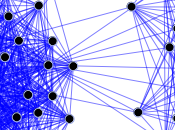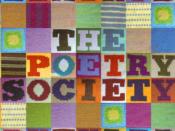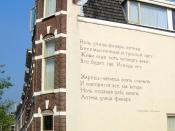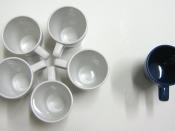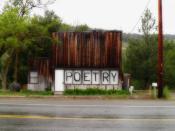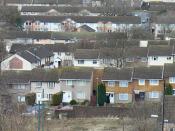1)The poem is primarily concerned with the ideals of obtaining a certain kind of lifestyle. In order to obtain that certain lifestyle where one is accepted and acknowledged by his/her peers, certain criteria must be met. i.e. ÃÂAll went to the university, And there's doctors and lawyers, And business executives, And they all play on the golf courseÃÂIn this way, the author of the poem is conveying the sense of social inclusion versus social exclusion. If one wanted to be considered a part of the community at large, one must then abide by all the following conditions in order to become complete.
In essence, these conditions come in the form of materialistic endeavors, i.e. become either a doctor or a lawyer or a business man, complete university, get married, live in a nice house and raise children where ÃÂthey all look just the sameÃÂ.
Moreover, the poem repeatedly conveys the continuance of obtaining such accomplishments from father and son and so on in order to keep the idealistic lifestyle.
2)What comes to mind in terms of setting is the uniformity and limitations of these people living in this environment of this higher class society. The monotony of belonging to such an upper class or white collar society is what is described in the poem by the repeated suggestion that ÃÂthey all look just the sameÃÂ. The setting is made to convey a social environment which seems almost ÃÂassembly line producedÃÂ in the sense that everyone has the same job, has the wife and kids and leads the same activities day in and day out.
It may seem that the author may be criticizing these ideals of conformity made by these individuals because they lack any sense of originality or variety. The author continues to indicate in each paragraph that ÃÂthey all get put into these boxesÃÂ which gives the impression that these individuals are living a good life but are then limited or restricted to these ideals. This implies these people are unhappy, or/and feel incomplete. Therefore, the setting describes a static and unchanging community.
3)The characters in this poem are the boxes; the people separated from the rest in terms of division of social class. In this case, the distinction is made by money and wealth. Therefore, the characters in this poem are those who have the education and wealth to live in these little boxes and allow their children to become ÃÂjust the sameÃÂ.
4)Symbols are used when she says ÃÂWhere they are put in boxes.ÃÂ The boxes symbolize the expectations/ideals society surrounds us in, in order to have the ÃÂperfect lifeÃÂ. The poet uses visual imagery in describing the boxes. The poet starts out by describing the boxes on the hillsides and the variety of colors displayed by each of these boxes. Tactile imagery is also used when describing the boxes made out of ÃÂticky-tackyÃÂ. The tactile imagery is played upon in this poem as each verse goes onto describe its subjects as ÃÂall made out of ticky-tackyÃÂ. The dominant image is one of a ÃÂwhite collarÃÂ society, where there is a lack of variety or surprise, and everyone is rich and snotty.
5)The feeling of the poem seems to be one which pokes fun at the middle-upper class lifestyle. It seems to criticize the wealthy and the educated for leading such predictable and almost too boring lifestyles.
In contrast to the phrase ÃÂthink outside of the boxÃÂ, this poem plays on just the opposite. The author gives off the impression that being a doctor or a lawyer and drinking martinis while the children go to camp is not all that there can be to life, unless one wants to become just another one of the same.
It then seems that a static lifestyle where everything is predictably dull and dreary can be quite unappealing. Therefore, the mood of the poem is one that conveys a sense of comic relief to ordinary citizens from the pressures of not belonging to the group of people in the box because the rewards to it are predictably ÃÂall just the sameÃÂ.
6)The theme is conformity and the continuation of the upper class society. It is a theme which speaks of social inclusion versus social exclusion. In order to become inclusive as a member of this community, certain standards must be upheld. i.e ÃÂall went to the universityÃÂ and ÃÂall have pretty childrenÃÂ. When these standards are not met, then the ÃÂidealÃÂ lifestyle is not obtained.
7)A major sense which is valid in this case is visual imagery. The author starts out by describing the boxes on the hillsides and the variety of colors displayed by each of these boxes. From the beginning we are presented with this imagery of uniformity and alikeness.
Secondly, the tactile imagery is played upon in this poem as each verse goes onto describe its subjects as ÃÂall made out of ticky- tackyÃÂ. It is not clearly stated what this ÃÂticky-tackyÃÂ substance would feel like to the touch, but what is conveyed is that whatever these subjects feel like, it is that they all feel just the same. Again, a feeling of uniformity and lack of the element of surprise has been described in the continuous repetition of the same kind of touch and feeling when living such a boring a predictable lifestyle.
8)The nuclear family in a well-to-do neighborhood with a high standard of living is the dominant imagery which comes to mind from this piece. The picture of a white collar neighborhood, free from crime, free from surprise or variety is what is portrayed by this piece. Seemingly criticizing the lifestyle to look very dull and essentially life-less, one is reminded of the ÃÂStepford WivesÃÂ movie adaptation of the seemingly perfect but nevertheless flawed imagery of the family ideal.
